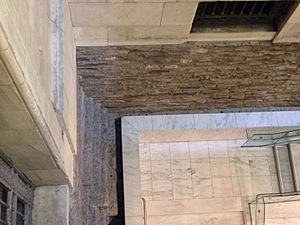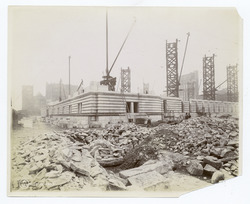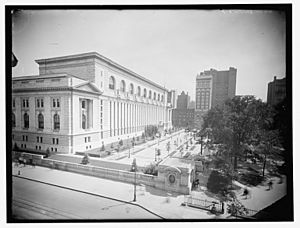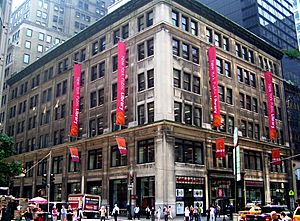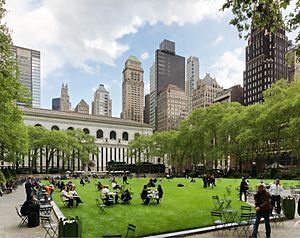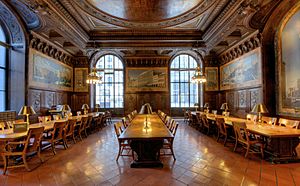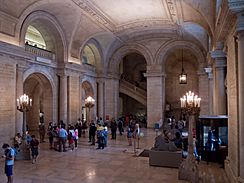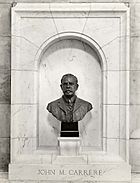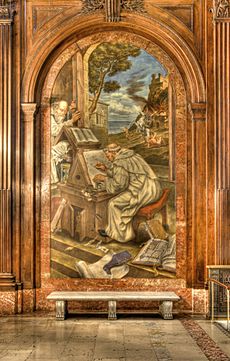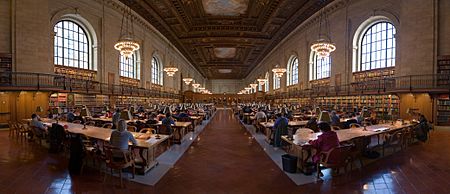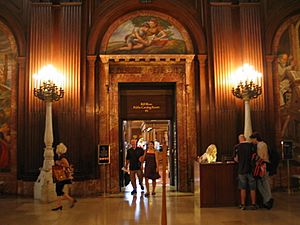New York Public Library Main Branch facts for kids
Quick facts for kids New York Public Library Main Branch |
|
|---|---|
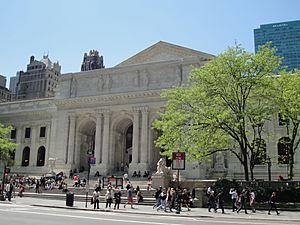 |
|
| Main entrance on 5th Avenue, 2011 | |
| Country | United States |
| Type | Research library |
| Established | May 23, 1911 (opened to public) |
| Location | 476 Fifth Avenue, Manhattan, New York 10018 |
| Branch of | New York Public Library |
| Collection | |
| Items collected | Approximately 2.5 million (2015[update]) |
The Stephen A. Schwarzman Building, also known as the Main Branch or the New York Public Library, is the most important building in the New York Public Library system. It is a famous landmark in Midtown Manhattan, New York City. This branch is one of four special research libraries in the system and has nine different sections.
The building has four floors that are open to the public. You can find the main entrance steps on Fifth Avenue at East 41st Street. As of 2015, the library holds about 2.5 million books in its storage areas. In the 1960s, the building was named a National Historic Landmark and a special landmark by New York City.
The Main Branch was built after two libraries joined together in the late 1890s to form the New York Public Library. It stands on Fifth Avenue, between 40th and 42nd Streets, right next to Bryant Park. The architectural firm Carrère and Hastings designed the building in the beautiful Beaux-Arts style. It first opened its doors on May 23, 1911.
The building's outside is made of marble with fancy details. Two stone lions guard the Fifth Avenue entrance. They have become a symbol of the library. Inside, you'll find the huge Main Reading Room, which is about 78 feet wide and 297 feet long, with a 52-foot-high ceiling. There's also a Public Catalog Room, other reading rooms, offices, and art displays.
The Main Branch quickly became very popular. By the 1920s, about 4 million people visited it each year. The library added more storage space for books under Bryant Park in 1991. The Main Reading Room was fixed up in 1998. A big renovation happened from 2007 to 2011, thanks to a $100 million gift from Stephen A. Schwarzman, which is why the building is now named after him. Since 2018, the library has been getting even more updates.
You might have seen the Main Branch in many TV shows like Seinfeld and Sex and the City. It has also appeared in movies such as The Wiz (1978), Ghostbusters (1984), and The Day After Tomorrow (2004).
History of the Library Building
The New York Public Library was created in 1895 when the Astor and Lenox Libraries joined forces. A large gift from Samuel J. Tilden and a donation from Andrew Carnegie helped make this huge library system possible. After joining, the libraries had 350,000 items. The founders wanted a grand main building for the new library.
They chose a new spot on Fifth Avenue, between 40th and 42nd Streets. This location was perfect because it was in the middle of the old Astor and Lenox Libraries. An old water reservoir, called the Croton Reservoir, used to be there. You can still see parts of it under the library today.
Dr. John Shaw Billings, the first director, drew up early plans for a massive reading room above seven floors of book storage. His idea was to create a very fast system to get books to readers. His design became the basis for the Main Branch.
Building the Library
In 1897, New York State allowed the old reservoir site to be used for the library. A competition was held, and 88 architects submitted designs. The firm of Carrère and Hastings was chosen to design the new library. They even made a model of the building that was shown at New York City Hall in 1900.
Construction faced some delays, but work on digging out the old reservoir began in June 1899. By 1901, most of the reservoir was gone. A special ceremony for the start of construction happened in August 1902, and a cornerstone was laid on November 10, 1902. This cornerstone held a box of items from the library and the city. Building the Main Branch, along with the nearby Grand Central Terminal, helped make Bryant Park a better place.
Work on the library continued slowly. The basement was finished by 1903, and the first floor by 1904. The outside work was delayed, and by August 1904, it was only half done. By December 1906, the roof was finished. The final steps involved putting in all the furniture and details inside. By the end of 1907, the outside of the building was mostly complete.
Workers started painting the main reading room and catalog room in 1908. The next year, furniture began to be installed. Starting in 1910, about 75 miles of shelves were put in to hold the books. It took a whole year to move and arrange all the books from the Astor and Lenox Libraries. The library was almost finished by late 1910. One of the architects, Carrère, passed away before the building opened.
Opening Day
On May 23, 1911, the New York Public Library's main branch officially opened. About 15,000 guests attended the ceremony, including President William Howard Taft. The next day, May 24, the public was invited, and tens of thousands of people came to see the library.
The first book requested was Philosophy of the Plays of Shakespeare Unfolded. However, that book wasn't actually in the library yet! This was a trick to get attention. The first book truly given to a reader was N. I. Grot's Ethical Ideas of Our Time. The reader asked for it at 9:08 a.m. and got it just seven minutes later.
The Beaux-Arts Main Branch was the largest marble building in the United States at that time. It held 3.5 million books across 375,000 square feet. The final cost to build it was about $9 million. In its first week, the library was so busy that officials estimated 250,000 people visited!
Growing Through the Years
The Main Branch quickly became known as an amazing building. In 1971, a critic from The New York Times said the library still fit the city very well.
The library also became a major place for research. Many famous people used it, including First Lady Jacqueline Kennedy Onassis, writers like Norman Mailer, and actors like Marlene Dietrich. Even inventors used the library. Edwin H. Land researched here before inventing the Land Camera (an early instant camera). Chester Carlson invented Xerox photocopiers after studying at the library. During World War II, American soldiers even used a rare Mexican phone book from the Main Branch to decode a Japanese secret message!
1920s and 1930s
By 1926, the library was very busy, with up to 1,000 people asking for books every hour. About 4 million people used the Main Branch each year by 1928. Because so many books were needed, new shelves were added in the storage rooms.
In 1935, the Bryant Park Open-Air Reading Room was created for the summer. This was meant to cheer up readers during the Great Depression. It stayed open until 1943. In 1937, doctors Albert and Henry Berg offered to donate their amazing collection of rare English and American literature. The Berg Reading Room was officially opened in October 1940.
During the 1930s, workers from the Works Progress Administration (WPA) helped take care of the Main Branch. They fixed the heating, lighting, and stairs, and painted many parts of the building.
Later 20th Century Changes
During World War II, the large windows in the Main Reading Room were covered, but they were later uncovered. After the war, the Main Reading Room became a bit neglected. In 1949, the library asked the city to take over the circulating (borrowing) and children's libraries.
By the mid-1960s, the Main Branch had 7 million books and needed more space. The circulating collection moved to the nearby Mid-Manhattan Library in 1970. In the 1970s, the library faced money problems. As a result, the Main Branch closed on Sundays and holidays for a while. The famous lion statues outside were also cleaned up in 1975.
The Catalog Room was restored starting in 1983. Millions of old, worn-out catalog cards were replaced with copies. This room was later named for Bill Blass, a fashion designer, who gave $10 million to the library.
In the late 1980s, the library decided to expand its book storage under Bryant Park. This was a huge project. It meant closing Bryant Park, digging it up, and then rebuilding it. The library added more than 120,000 square feet of storage space and 84 miles of bookshelves under the park. This doubled the amount of storage space at the Main Branch. The new storage areas were connected to the main building by a 120-foot tunnel. Bryant Park reopened in mid-1992 after a three-year renovation.
The Main Reading Room was closed for renovations in July 1997. It was restored over 16 months and reopened in November 1998. The work included cleaning and repainting the ceiling, cleaning windows, and fixing the wood. It was renamed the Rose Main Reading Room after a family who donated $15 million for the renovation.
21st Century Updates
Modern Renovations
In the early 2000s, a four-story glass building was added to the South Court, an enclosed area on the library's south side. This new structure opened in 2002.
By 2004, the white marble outside the building was getting dirty from pollution. In 2007, the library announced a big renovation of the building's exterior. The marble and statues needed to be cleaned and repaired. The goal was to finish the work by the library's 100th birthday in 2011.
Stephen A. Schwarzman gave $100 million for the renovation and expansion. In 2008, the library announced the building would be renamed in his honor. British architect Norman Foster was chosen to design the renovations.
Recent Changes and the "Book Train"
In 2012, a plan was announced to close other library branches and turn the Main Branch into a circulating library. This plan would have moved over a million books into storage far away. Many people disagreed with this idea, calling it "cultural vandalism." After a long fight, the plan was stopped in May 2014.
In May 2014, a piece of the ceiling fell in the Rose Main Reading Room. The room was closed for repairs. The $12 million project included fixing the ceiling and adding new lights. The library also replaced its old book delivery system with a new one called the "book train." This new system uses small red carts to carry books quickly between the storage areas and the reading rooms. The restored Rose Main Reading Room and Public Catalog Room reopened on October 5, 2016.
In November 2017, the library approved a $317 million plan for the Main Branch. This would be the biggest renovation in its history. The plan aims to make 20 percent more space open to the public, add a new entrance, and create a center for high school and college students. Construction started in July 2018 and is expected to finish in 2021.
Inside the Library
The Main Branch has four floors that you can visit: the ground level, and the first, second, and third floors. On each floor, there's a long hallway on the east side of the building. The library originally had over 200 rooms. The building's design includes many fancy details, even on doorknobs and trash cans!
Main Public Areas
- Ground Floor: This floor has an entrance on 42nd Street. It used to have a coat-check, a circulating library, and a newspaper room. Now, it includes a children's book room and a temporary branch of the Mid-Manhattan Library.
- First Floor: When you enter from Fifth Avenue, you arrive in the first-floor lobby, called Astor Hall. This floor has the Picture Collection, Periodical Room, and the Jewish Division. You'll also find the Milstein Division (for U.S. History and Genealogy) and the Map Division here. The library shop and other exhibition spaces are also on this floor.
- Second Floor: This floor has the Jill Kupin Rose Gallery, which shows different exhibitions. It also contains special rooms like the Wachenheim Trustees' Room, with its beautiful wood and marble fireplace.
- Third Floor: This floor is home to the McGraw Rotunda, a grand space in the middle. From here, you can go to the Bill Blass Public Catalog Room, which then leads to the very large Rose Main Reading Room. Other special collections like the Wallach Division (Art, Prints, and Photographs), Berg Collection (English and American Literature), and Pforzheimer Collection (Romanticism) are also on this floor.
Astor Hall
Astor Hall is the main lobby on the first floor, right after you come up the steps from Fifth Avenue. It's a large space, 70 feet by 44 feet, with a 34-foot-high ceiling. The whole hall is made of stone. The names of important donors are carved into the pillars.
Two grand marble staircases on the north and south sides of Astor Hall lead up to the second floor. At the bottom of these stairs, you'll see bronze statues (busts) of the architects, Carrère and Hastings. Another set of stairs leads from the second floor up to the McGraw Rotunda on the third floor.
McGraw Rotunda
The McGraw Rotunda is a rectangular room on the third floor. It connects the Public Catalog Room and the Salomon Room. This rotunda has red marble at the bottom, dark wood walls, and a plaster ceiling. The walls have special spots for murals.
The rotunda features a set of paintings by Edward Laning from the early 1940s. These paintings show the history of the written word. For example, one painting above a doorway is called "Learning to Read." The ceiling painting is called "Prometheus Bringing Fire to Men."
The Rose Main Reading Room, also known as Room 315, is on the third floor. It's huge, about 78 feet wide and 297 feet long, with a 52-foot-high ceiling. It's almost as big as the main hall in Grand Central Terminal! The room was renovated and renamed for the Rose family in 1998–1999. Its ceiling was fixed again in 2016. In 2017, it became a New York City landmark.
The room has long wooden tables and chairs with brass lamps. Each spot at a table has a number. This helps library staff deliver books to the right person from the storage areas. You can also use computers here to search for books or use the internet. Thousands of reference books are on open shelves around the room, which you can read freely.
Big windows and grand chandeliers light up the room. There are 18 large archways, and 15 of them have windows looking out to Bryant Park or facing east. The ceiling is made of plaster painted to look like fancy gilded wood. It has detailed carvings and a large mural by James Wall Finn that shows clouds and sky.
Public Catalog Room
The Bill Blass Public Catalog Room is next to the Main Reading Room and connects it to the McGraw Rotunda. It's like a waiting area for the Main Reading Room. This room is 81 feet by 77 feet and also has a 52-foot-high ceiling. Four chandeliers, just like those in the Main Reading Room, hang from the ceiling.
The Catalog Room was restored in 1983 and renamed for Bill Blass in 1994. It has waist-high oak desks with computers where you can search the library's catalog.
Salomon Room
The Edna Barnes Salomon Room, located east of the McGraw Rotunda, is often used for events. It was originally a picture gallery, and oil paintings still hang on its walls. In 2009, it became a "wireless Internet reading and study room" for people who needed extra space to work online.
Book Storage Areas
The library has many stacks (storage areas for books). Under the Rose Main Reading Room, there are seven stories of central stacks that can hold 3.5 million books. As of 2015, these central stacks are not used for books due to their condition.
Another 84 miles of stacks were added under Bryant Park between 1987 and 1991. These "Bryant Park stacks" have two levels of climate-controlled storage. The first level holds 1.2 million books. The second level, called the "Milstein Stacks," opened in January 2017 and is now home to 2.5 million more books.
Books are delivered from the Bryant Park stacks to the reading rooms using the "book train." This $2.6 million system was installed in 2016. It uses a conveyor belt and 24 small red carts, each carrying up to 30 pounds of books. Each cart moves 75 feet per minute and can climb steep slopes. This new system is twice as fast as the old one!
Outside the Library
The New York Public Library's Main Branch is 390 feet long from north to south and 270 feet wide from west to east. It sits on the east side of the block, facing Fifth Avenue. The north side of the building has entrances to the New York City Subway's Fifth Avenue station.
The library building is made of marble about three feet thick, along with brick. During construction, only the best marble was used. About 65% of the marble dug up for the library was rejected and used for other buildings. The outside is made of 20,000 stone blocks, each with a number. A fancy cornice with sculpted figures wraps around the top of the building.
Fifth Avenue Entrance
The Main Branch faces Fifth Avenue on its east side. A grand marble staircase leads up from Fifth Avenue to the main entrance. This entrance has a large porch with six tall columns and three archways. These lead to the first floor of the building, which is actually one story above ground.
Two large stone lions, made of Tennessee marble, guard the stairway. They were sculpted by the Piccirilli Brothers. These lions are a symbol of the New York Public Library. Their original names were "Leo Astor" and "Leo Lenox," after the library's founders. In the 1930s, Mayor Fiorello La Guardia nicknamed them "Patience" and "Fortitude." He chose these names because he felt New Yorkers needed these qualities to get through the Great Depression. Patience is on the south side (left when facing the entrance), and Fortitude is on the north side (right). The lions have been restored several times due to pollution, most recently in 2019.
Other Sides of the Building
The north side of the building is along 42nd Street, and the south side is along 40th Street. The north side has an entrance to the ground level. Both the north and south entrances have flagpoles with beautiful bronze bases. These were designed in 1912 by Thomas Hastings and made by sculptor Raffaele Menconi.
The building used to have an enclosed courtyard on its south side called the South Court. It was originally a place for horse carriages. A four-story glass building was built on this spot and opened in 2002.
Bryant Park Side
The west side of the library faces Bryant Park. This side has tall, narrow windows that let light into the book storage areas inside. Above these windows, near the top of the building, are nine large arched windows that light up the Rose Main Reading Room.
Special Collections
The New York Public Library's Main Branch has nine divisions, and eight of them are special collections. This means they hold unique or very rare items.
- General Research Division: This is the main division, located in the Rose Main Reading Room. It has 43 million items in over 430 languages.
- Milstein Division of U.S. History, Local History and Genealogy: This division has one of the largest collections for family history (genealogy) in North America. It includes documents from towns, cities, and states across the U.S., and genealogies from around the world.
- Map Division: Created in 1898, this division has over 20,000 atlases and 433,000 maps, some dating back to the 16th century.
- Manuscripts and Archives Division: This division holds over 5,500 collections, including ancient cuneiform tablets, illuminated manuscripts from the Middle Ages, and important papers from famous people and groups.
- Dorot Jewish Division: Founded in 1897, this division has documents and books about Jewish subjects and the Hebrew language.
- Berg Collection of English and American Literature: This collection has rare books, first editions, and original writings in English and American literature. It includes over 35,000 works from 400 authors.
- Pforzheimer Collection of Shelley and His Circle: This collection has about 25,000 works from the English Romanticism period (18th and 19th centuries). It includes works by famous poets like Percy Bysshe Shelley and Lord Byron.
- Rare Book Division: To visit this division, researchers need to sign up first. It has 800 books printed in Europe before 1501, old American books, and newspapers. It also has rare Bibles, including the first Gutenberg Bible brought to the U.S.
- Wallach Division of Art, Prints and Photographs: This collection includes over one million works of art and 700,000 books and magazines about art.
Library Way
On 41st Street, between Park and Fifth Avenues, you'll find Library Way. This is a series of bronze plaques on the sidewalk. Each plaque has a quote from a famous author or poet. There are 48 unique plaques, and each one is duplicated on both sides of 41st Street, making a total of 96 plaques. These quotes were chosen in the 1990s.
Landmark Status
The Main Branch was named a National Historic Landmark in 1965. The outside of the building was also named a New York City landmark in 1967. Later, in 1974, parts of the interior, like Astor Hall and the McGraw Rotunda, were also given landmark status. In 2017, the Rose Main Reading Room and Public Catalog Room were also named New York City landmarks.
The Library in Movies and TV
The Main Branch has appeared in many films and TV shows:
- 42nd Street (1933)
- The Clock (1945)
- On the Town (1949)
- Pickup on South Street (1953)
- Breakfast at Tiffany's (1961)
- Two for the Seesaw (1962)
- You're a Big Boy Now (1966)
- The Possession of Joel Delaney (1972)
- Network (1976)
- The Wiz (1978)
- Ghostbusters (1984)
- Prizzi's Honor (1984)
- Regarding Henry (1991)
- Quiz Show (1994)
- Picture Perfect (1997)
- The Thomas Crown Affair (1999)
- Finding Forrester (2002)
- Head over Heels (2001)
- Maid in Manhattan (2002)
- Spider-Man (2002)
- The Time Machine (2002)
- 13 Going on 30 (2004)
- The Day After Tomorrow (2004)
- Shortcut to Happiness (2004)
- Spider-Man 3 (2007)
- Sex and the City (2008)
- Uncertainty (2008)
- Arthur (2011)
- The Adjustment Bureau (2011)
- We'll Take Manhattan (2012)
- Winter's Tale (2014)
- Ex Libris: The New York Public Library (2017)
TV shows that showed the Main Branch include "The Library" from Seinfeld, and "The Persistence of Memory" from Carl Sagan's Cosmos.
The Library in Books
The Main Branch also appears in many books, including:
- Lawrence Blochman's Death Walks in Marble Halls (1942)
- Jane Smiley's Duplicate Keys (1984)
- Allen Kurzweil's The Grand Complication (2001)
- Cynthia Ozick's Heir to the Glimmering World (2004)
- Lynne Sharon Schwartz's Writing on the Wall (2005)
Poems about the library include:
- E. B. White's "A Library Lion Speaks" and "Reading Room" (1981)
- Richard Eberhart's "Reading Room, The New York Public Library" (1988)
- Lawrence Ferlinghetti's "Library Scene, Manhattan" (2001)
Images for kids
-
The Main Branch has a Gutenberg Bible, one of the first books ever printed.
See also
 In Spanish: Sede de la Biblioteca Pública de Nueva York para niños
In Spanish: Sede de la Biblioteca Pública de Nueva York para niños


